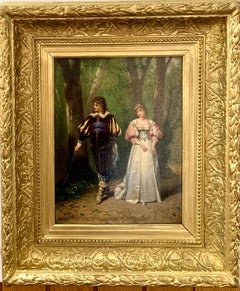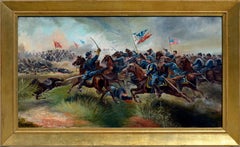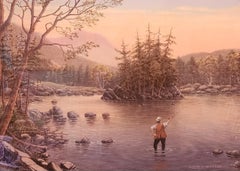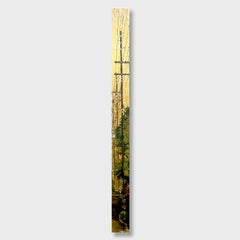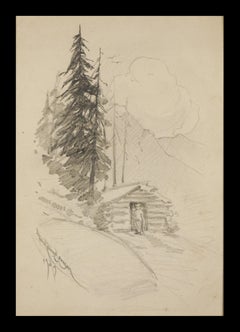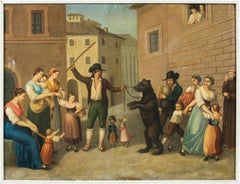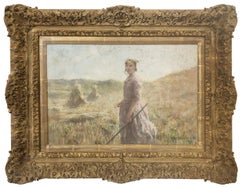Sword Landscape Paintings
to
2
3
1
1
3
Overall Width
to
Overall Height
to
1
2
2
3
1
1
5
1
4
3
330
12,255
11,244
10,270
5,156
4,467
3,970
3,969
3,267
2,861
2,310
1,976
1,850
1,838
1,805
1,719
1,651
1,636
1,501
1,365
7
6
4
3
1
1
1
5
7
1
Art Subject: Sword
19th century French scene of Lovers walking in a Garden, in 17th century costume
Located in Woodbury, CT
19th century French scene of Lovers walking in a Garden, in 17th century costume
original frame
Wonderful 19th century classical Genre scene, painted with great skill and delicasicy .
The artist has captured the meetiung of the two lovers...
Category
1870s Victorian Figurative Paintings
Materials
Canvas, Oil
Van Den Bossche Alexander The Great Paint Oil on canvas 17/18th Century Flemish
Located in Riva del Garda, IT
Balthasar Van Den Bossche (Antwerp, 1681 - 1715)
Alexander the Great and Campaspe in the studio of the painter Apelles
The canvas was exhibited in Perugia (Museo di Palazzo della Pe...
Category
17th Century Old Masters Paintings
Materials
Oil
1880s Figurative Sackett's Calvary Charge of the 9th New York Volunteers
Located in Soquel, CA
Late 19th century figurative painting of the battle of Trevilians Station and of the wounding of Colonel Sackett June 11, 1864. Oil on canvas in giltwood frame. Signed or notated indistinctly lower right. Image, 20.25"H x 36.25"W.
Military History Prior to 1865
The 9th New York Cavalry contained two companies from Cattaraugus County. It was mustered into the service October 1, 1861 and, until mustered out in July, 1865, lost 619 officers and men out of a total enlistment of a little less than two thousand. It participated in many battles and skirmishes and lost its colonel, William Sackett, who was killed at Trevilian Station, Virginia, on June 11, 1864.
From the Albany Evening Journal, July 20, 1864:
Another name is added to the list of hero martyrs who have fallen in the service of their country. Col. WILLIAM SACKETT, of the Ninth New-York Cavalry, (son of Hon. W.A. SACKETT,) was mortally wounded in the engagement, under Gen. SHERIDAN, at Pavillion Station, Va., and died on the 14th ult. As he was left behind, the sad intelligence of his decease has but just been received.
Col. SACKETT had seen much service. He entered the army on the 22d of April, 1861, was appointed Major of the Ninth New-York Cavalry in October of the same year, was promoted to Lieutenant-Colonelcy in August, 1862, and in March, 1863, became commander of the regiment. He was with Gen. MCCLEELAN in the Peninsula campaign, was in all the cavalry actions of the campaign which followed, was with the army in its advance after the battle of Antietam, and in almost constant conflict with the enemy until after the battle of Fredericksburgh. He participated in most of the cavalry engagements under Gen. HOOKER's command, was in all the principal cavalry actions during LEE's invasion of Maryland and Pennsylvania in 1863, and was among the first engaged in the terrible conflict at Gettysburgh, where he performed distinguished service in holding a rebel brigade in check a long time while our forces were getting into position on the crest of the hill. He was active in the cavalry skirmishes which ensued in the latter part of the Summer.
During the present campaign he was with Gen. SHERIDAN in all his brilliant expeditions up to the time when he fell. He died while leading a charge against the enemies of his country -- died, as he wished to die, doing his whole duty. He was brave, he was generous, he was unflinchingly faithful to the cause of the Union. He loved the old flag with a love that was stronger than life, and esteemed it glorious to fall in its defense. He was born in Seneca Falls, and was 25 years of age.
When the great civil war broke out [William Sackett] was practicing law at Albany, N. Y., having a short time previous been admitted to the bar. In December, 1861, he was commissioned Major of the 9th Regiment of New York Cavalry, and taking the field served with credit in several engagements in which that command participated. On June 27, 1862, his immediate superior, Lieutenant- Colonel Hyde, resigned and three days later Major Sackett was commissioned to fill the vacancy. On the 30th of the following May he was advanced to the Colonelcy of his regiment, with rank from March 15, 1863.
It is stated in "Battles and Leaders of the Civil War" that the cavalry pickets commanded by Colonel Sackett fired the first shot at the battle of Gettysburg. He subsequently led his command, in a gallant manner, in numerous engagements, including the battle of Trevilians Station, fought June 10, 1864. There he received a mortal wound and died inside of the enemy's lines some three days later. The report that he had been severely wounded and was in the hands of the enemy soon reached his wife, who immediately determined to make an effort to reach and care for him, not knowing that he was already dead when the report reached her. The following correspondence, copied from Official Records published by the War Department, tells in most emphatic terms of her devotion.
City Point, Va., July 7, 1864.
General R. E. Lee, Commanding Confederate Army,
Mrs. Sackett, the wife of Colonel William Sackett, who was wounded on the 11th of June, near Trevilians Station, Va., is here in deep distress and feeling great anxiety to learn the fate of her husband. Colonel Sackett was left at a house some two miles and a half from the station, in charge of...
Category
1880s American Impressionist Figurative Paintings
Materials
Oil, Linen
Street in the Snow, Landscape, Original oil Painting, Ready to Hang
Located in Granada Hills, CA
Artist: Alex Kalenyuk
Work: Original oil painting, handmade artwork, one of a kind
Medium: Oil on canvas
Year: 2021
Style: Impressionism
Title: Street in the Snow
Size: 6" x 8" x ...
Category
2010s Impressionist Landscape Paintings
Materials
Canvas, Oil
Fly Fising in a Mountain Stream
Located in Saratoga Springs, NY
Signed lower right.
Albert Nemethy Jr.'s pastel paintings beautifully capture the essence of nature, showcasing his mastery of light, texture, and atmo...
Category
1990s Hudson River School Landscape Paintings
Materials
Pastel, Synthetic Paper
Impressionistic Cityscape Acrylic Painting, "Alley Totem No. 4"
Located in San Diego, CA
This is a one-of-a-kind original acrylic and gold leaf still life painting by San Diego artist, Duke Windsor. Its dimensions are 5" x 70" x 2.5" in (L x H x D). It is unframed. A cer...
Category
2010s Impressionist Landscape Paintings
Materials
Gold Leaf
"The Riverbank" Charles Sprague Pearce, American Impressionist Boat Sketch
Located in New York, NY
Charles Sprague Pearce
The Riverbank, circa 1900
Signed lower left, inscribed verso
Oil on canvas
7 1/2 x 5 1/2 inches
Charles Sprague Pearce made a successful career painting high...
Category
Early 1900s American Impressionist Figurative Paintings
Materials
Canvas, Oil
Queen Paris Knighting William
By Brett Osborn
Located in Atlanta, GA
Brett Eric Osborn was born in Lima, Ohio in 1963. Both his father and his cousin are artists and influenced the young Osborn during his formative years. Brett recalls being a child d...
Category
21st Century and Contemporary American Impressionist Landscape Paintings
Materials
Oil
Related Items
Early 20th Century Plein Air Study for Homesteader Colorado Mountain Painting
Located in Soquel, CA
Robert Azensky Fine Art is pleased to offer original 1909 sketch study of oil painting "Homesteader Colorado Mountain" painting by Frank Tenney Johnson.
It's always special to see the evolution of a painting through the plein air sketches ("studies") by the artist prior to its painting. Frank Tenney Johnson traveled throughout the Colorado Rockies sketching and painting western landscapes and native American and cowboy figurative art.
Medium: Charcoal on paper
Signature: Lower left corner
Date: "1909" below signature
Condition: Tonal aging and minor edge wear consistent with age and use. See images.
Presented in black painted wood frame
Mat size: 14"H x 11"W
Paper size: 9"H x 6"W
Image size (visible with mat): 8"H x 5.25"W
Frank Tenney Johnson was born in Coucil Bluffs, Iowa, in 1874 not far from the Overland Trail. During his childhood, he saw the steady stream of people heading west in all forms of horse-drawn conveyance. This early exposure to the American West was critical in leading Johnson towards the Western landscape as an inspiration for his work. The resulting body of work is a moody and romantic depiction of a long-gone America, rendered in a style that has become practically a genre all its own.
At the age of ten, Johnson moved from Iowa to Milwaukee, WI. There, he took an apprenticeship with F.W. Heinie, a prominent panoramic painter. After a year with Heinie, Johnson apprenticed for Richard Lorenz, a painter and former Texas Ranger who specialized in depictions of horses and western scenes. It was probably during his time with Lorenz that Johnson decided to focus on western subjects himself. He also started illustrating for regional papers and publications, in order to save money for further training.
Further training, as with many of the artists who populated New Mexico in the early twentieth century, took place at the Art Students League in New York, where Robert Henri, William Merritt Chase, John Twachtman, Kenneth Hayes Miller and F. Louis Mora were in the process of teaching perhaps the last great batch of pre-modernists. Though highly stimulated by the training, Johnson was only able to stay for five months, after which he returned to Milwaukee to work and save money in an effort to return to New York. He was able to do so after a time and, upon returning, established an important professional relationship with Emerson Hough, the editor of "Field & Stream" magazine.
At Hough's urging (and on Hough's dime), Johnson traveled to Hayden, Colorado, where he tagged along with a group of cowpunchers in order to sketch their way of life. Though primarily an artist, Johnson also wrote accounts of his time in Colorado for "Field & Stream." After Colorado came Cheyenne, Wyoming, where Johnson attended a "Frontier Days" celebration; after Wyoming, Johnson traveled to New Mexico, where he observed the Navajos and their threatened way of life. This trip changed Johnson from an academic artist with an appreciation for the west to a truly western artist.
Of particular interest to him, in stark contrast to other western artists of the time like Frederic Remington and C.M. Russell, were the more quotidian scenes of the West. Specifically, Johnson focused upon scenes featuring horses, especially at night. Johnson painted a great number of pieces that featured horses tied up outside of saloons, inns or trading posts for the night, the moonlit night punctuated by the warm glow from the lamps inside. In this, he can be considered a pioneer, as his night pieces still serve as the archetype for such work in western art.
Johnson became quite successful through his work for "Field & Stream." He was chosen to illustrate books by the prominent writer Zane Grey, and his gallery shows sold briskly. In fact, one particular show, at the Grand Central Art Galleries at the Biltmore Hotel in New York, sold out opening night. In fact, one man had bought out the entire show: Amon Carter. Having achieved financial security and comfort, Johnson followed his good friend Clyde Forsythe to Alhambra, CA, where the two established residency and shared a studio.
California treated Johnson well. He and Forsythe founded the gallery at the Los Angeles Biltmore...
Category
Early 1900s Hudson River School Landscape Paintings
Materials
Oil Crayon, Laid Paper
Original-Moonlight in Snowy Night-Gold Leaf-British Awarded Artist-impressionist
Located in London, GB
-In light of new tariffs, we’ve applied a 20% discount off the market price of this piece to support our collectors in facing potential added costs. At the gallery, we work closely w...
Category
2010s Impressionist Abstract Paintings
Materials
Gold Leaf
H 15.75 in W 11.82 in D 0.52 in
Golden Tree Landscape
Located in Soquel, CA
Enchanting oil painting of a glowing textured tree layered with gold leaf and deep purples by an unknown artist (American, 20th Century). Unsigned. Painted on heavy 1/4" artists boa...
Category
Late 20th Century American Impressionist Landscape Paintings
Materials
Gold Leaf
Original-Gladiolus in Bloom-Brit Awarded Artist-Exhibition Collection-Gold leaf
Located in London, GB
Summer Bloom series began in 2022, which Shizico Yi celebrates the season by painting en plein air in her garden. In 2024, she embarks on a fresh chapter with her new cottage garden;...
Category
2010s Impressionist Abstract Paintings
Materials
Gold Leaf
H 19.69 in W 15.56 in D 0.6 in
"Evening View to the South West" , Oil Painting
Located in Denver, CO
David Grossman's (US based) "Evening View to the South West" is an original, handmade oil painting that depicts a wide open plain of the West with fields of...
Category
2010s American Impressionist Landscape Paintings
Materials
Linen, Oil, Panel
Antique American Hudson River School Landscape Cows Oil Painting Gilt Frame 19th
Located in Buffalo, NY
Antique Quintessential American Hudson River School landscape by an unknown Hudson River School artist.
This painting features its original period gold frame, and a charming scene o...
Category
1860s Hudson River School Landscape Paintings
Materials
Canvas, Oil
The Road to Emmaus, German Old Master Painting
Located in Stockholm, SE
German School, 1700s
The Road to Emmaus
oil on panel
unframed: 24.3 x 17.5 cm (9.6 x 6.9 inches)
framed: 34.5 x 28 cm (13.6 x 11 inches)
Provenance:
Swedish author and artist Amel...
Category
18th Century Old Masters Figurative Paintings
Materials
Oil, Wood Panel
1880s Original Hudson River School Landscape -- Sunset Through The Forest
By Charles Russell Loomis
Located in Soquel, CA
Beautiful Hudson River School Original gouache autumnal landscape of vivid sunset through forest by Charles Russell Loomis (American 1857 - 1936), circa 1880. Warm and cool tones wit...
Category
1880s Hudson River School Landscape Paintings
Materials
Paper, Gouache, Cardboard
David Bates, Behind The Village, Capel Curig
Located in Cheltenham, GB
This early 20th-century oil painting by British artist David Bates (1840-1921) depicts a rural view in Capel Curig, North Wales. Bates was an accomplished landscape painter who often...
Category
Early 1900s Victorian Landscape Paintings
Materials
Canvas, Oil, Board
Edward William Cooke RA, West-Country Cove With Cottages, Family & Donkeys
Located in Cheltenham, GB
This idyllic late 19th-century oil painting by English artist Edward William Cooke RA (1811-1880) depicts a west-country cove with two cottages, donkeys, figures, and fishing boats. Cooke was a highly renowned painter of marine scenes and landscapes who exhibited extensively at London’s Royal Academy.
From our elevated vantage point, the view extends between two quaint cottages and across the beach before sweeping around the sandy coastline. Crystalline waters lap the shore, where moored craft rest. It’s an accomplished rendering of a challenging composition. It’s enhanced by trees, which essentially ‘frame’ the right side, while a wooded track provides interest on the left.
Cooke was a keen admirer of the Dutch old masters, and the spirit of the Golden Age underpins this splendid work. In diaries, he recorded how he travelled by donkey to access elevated spots in the southwest, so it’s conceivable that he did so here. In his catalogue raisonné, it lists a work from the same year titled ‘Bay with Donkeys’.
Born in Pentonville, London, Cooke was raised in the company of accomplished artists as both his father, George Cooke (1781-1834), and his uncle, William Bernard Cooke (1778-1855), were engravers. As such, they were associated with a circle of Victorian painters who aided Cooke’s early development. These included the highly regarded marine painter Clarkson Frederick Stanfield RA RBA (1793-1867), who provided frequent advice and inspiration. Indeed, as a teenager, Cooke produced numerous drawings after Stanfield’s works.
A precocious talent, by the age of nine, he was already displaying an advanced understanding of engraving, particularly for ships, coupled with a natural, seemingly in-built skill as a draughtsman. Many of his early drawings depict pastoral landscapes after the masters, such as Nicolaes Berchem (1620-1683), Paulus Potter (1625-1654), and Karel Dujardin (1626-1678).
In an extraordinary turn of events, in 1820, his advanced abilities led to his first commission when he provided botanical illustrations for John Loudon's 'Encyclopaedia of Plants’. These were followed by drawings published in the 'Botanical Cabinet...
Category
1870s Victorian Landscape Paintings
Materials
Canvas, Oil
Hudson River School Coastal Seascape Framed Grand Manan Seascape Oil Painting
Located in Buffalo, NY
Finely painted American 19th Century Hudson River School landscape oil painting. Oil on board. Framed. No signature found. Measuring 17 by 20 inches overall and 8 by 12 painting ...
Category
1870s Hudson River School Landscape Paintings
Materials
Paper, Oil, Board
H 20 in W 17 in D 3 in
Victorian landscape painting of Scottish fishing boats moored in a bay
Located in Harkstead, GB
A very tranquil scene of fishing boats moored in harbour with a sunlit sea beyond. Painted with a most attractive palette of blues and greens and with a pleasing composition that le...
Category
19th Century Victorian Landscape Paintings
Materials
Canvas, Oil
H 16 in W 24 in D 2.5 in
Previously Available Items
Antique Italian painter - Early 19th century figure painting - The Trained Bear
Located in Varmo, IT
Italian painter (19th century) - The trained bear.
69.5 x 91.5 cm without frame, 71 x 93 cm with frame.
Antique oil painting on canvas, in a white wooden frame.
Condition report: ...
Category
Mid-19th Century Old Masters Landscape Paintings
Materials
Canvas, Oil
Young peasant, in the field with haystacks
By George Hitchcock
Located in Greenwich, CT
A most noted American artist with good representation in museums, known for his depictions of French peasant girls. The soft pastel medium lends a nostalgic and alluring feel to the subject. Hitchcock was an academically trained artist who was moving with impressionist influences. In La Paysanne Hitchcock draws attention to the importance of the single figure by placing her in the center of the page and at the meeting point of two hills in the distance. Furthering her importance, she looks directly at the viewer. Hitchcock frequently imbued ordinary landscape and figure representations with veiled biblical reference, here through a peasant who works the earth, placing her closer to God...
Category
1870s American Impressionist Figurative Paintings
Materials
Pastel, Archival Paper
